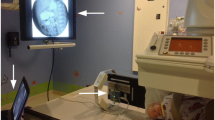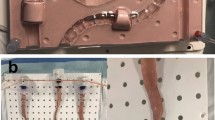Abstract
Background
Gastroesophageal balloon tamponade (BT) tube placement is a life-saving procedure for refractory bleeding from gastroesophageal varices performed by gastroenterologists, intensivists, internists, and emergency medicine physicians. Despite a recognized need for procedural training, no standard curriculum or assessment tools exist. Given the infrequent performance of this procedure, the development of a representative and accessible simulation model would permit hands-on training to practice and maintain proficiency with BT tube placement.
Aims
To assess BT tube placement performance before and after a novel simulation-based learning module in gastroenterology fellows and faculty.
Methods
A 16-item knowledge questionnaire and 22-item procedural skill checklist utilizing a novel 3D printed esophagus model were developed to assess participant knowledge, procedural skills, and confidence prior to our simulation-based intervention and again 8–12 weeks after. Performance metrics were compared pre- and post-intervention within groups and between participant groups.
Results
Fifteen gastroenterology fellows (of 15 eligible; 100%) and 14 gastroenterology faculty (of 29 eligible; 48%) completed training. Fellows demonstrated improvement in knowledge (55% to 79%, p < 0.001) and procedural skill (35% to 57%, p < 0.001) following training. Baseline faculty performance did not differ from fellows’ performance and post-intervention showed similar improvement in knowledge (61% to 77%, p = 0.001) and procedural skill (40% to 49%, p = 0.147). Overall satisfaction with training was high in both groups post-intervention and faculty felt more confident teaching fellows.
Conclusion
The presented learning module offers a unique, low stakes opportunity for learners to improve skills, gain knowledge, and build confidence in placing BT tubes using a realistic simulation model.



Similar content being viewed by others
References
Garcia-Tsao G, Abraldes JG, Berzigotti A, Bosch J. Portal hypertensive bleeding in cirrhosis: risk stratification, diagnosis, and management: 2016 practice guidance by the American Association for the Study of Liver Diseases. Hepatology 2017;65:310–335.
Jamal MM, Samarasena JB, Hashemzadeh M, Vega KJ. Declining hospitalization rate of esophageal variceal bleeding in the United States. Clin Gastroenterol Hepatol. 2008;6:689–695.
Stokkeland K, Brandt L, Ekbom A, Hultcrantz R. Improved prognosis for patients hospitalized with esophageal varices in Sweden 1969–2002. Hepatology 2006;43:500–505.
Lim N, Desarno MJ, Lidofsky SD, Ganguly E. Hospitalization for variceal hemorrhage in an era with more prevalent cirrhosis. World J Gastroenterol. 2014;20:11326–11332.
Hunt PS, Korman MG, Hansky J, Parkin WG. An 8-year prospective experience with Balloon Tamponade in emergency control of bleeding esophageal-varices. Dig Dis Sci. 1982;27:413–416. https://doi.org/10.1007/BF01295649.
Panes J, Teres J, Bosch J, Rodes J. Efficacy of Balloon Tamponade in treatment of bleeding gastric and esophageal-varices—results in 151 consecutive episodes. Dig Dis Sci. 1988;33:454–459. https://doi.org/10.1007/BF01536031.
Vlavianos P, Gimson AES, Westaby D, Williams R. Balloon Tamponade in variceal bleeding—use and misuse. Br Med J. 1989;298:1158–1158.
Avgerinos A, Armonis A. Balloon tamponade technique and efficacy in variceal hemorrhage. Scand J Gastroenterol. 1994;29:11–16.
Choi JY, Jo YW, Lee SS et al. Outcomes of patients treated with Sengstaken-Blakemore tube for uncontrolled variceal hemorrhage. Korean J Intern Med. 2018;33:696–704.
Escorsell A, Pavel O, Cardenas A et al. Esophageal Balloon Tamponade versus esophageal stent in controlling acute refractory variceal bleeding: a multicenter randomized controlled trial. Hepatology 2016;63:1957–1967.
Nadler J, Stankovic N, Uber A et al. Outcomes in variceal hemorrhage following the use of a balloon tamponade device. Am J Emerg Med. 2017;35:1500–1502.
Bajaj JS, Ananthakrishnan A, Saeian K. Survey of attitudes of AASLD members toward balloon tamponade. Hepatology 2005;41:1435–1436.
Chhina RS, Chawla LS. Inserting a Sengstaken-Blakemore (S-B) tube. Trop Dr. 1993;23:90–90.
Kaza CS, Rigas B. Rapid placement of the Sengstaken-Blakemore tube using a guidewire. J Clin Gastroenterol 2002;34:282–282.
McCormick PA, Burroughs AK, McIntyre N. How to insert a Sengstaken-Blakemore tube. Br J Hosp Med. 1990;43:274–280.
Murphy EP, O’Brien SM, Regan M. Alternative method of tractioning the Sengstaken-Blakemore tube. BMJ Case Rep. 2017. https://doi.org/10.1136/bcr-2016-218401.
Ortiz AM, Garcia CJ, Othman MO, Zuckerman MJ. Innovative technique for endoscopic placement of Sengstaken-Blakemore tube. Southern Med J. 2018;111:307–311.
Pasquale MD, Cerra FB. Sengstaken-Blakemore tube placement—use of balloon Tamponade to control bleeding varices. Crit Care Clin. 1992;8:743–753.
Powell MJJ. Sengstaken-Blakemore Tube. Treasure Island: StatPearls Publishing; 2021.
Chong CF. Esophageal rupture due to Sengstaken-Blakemore tube misplacement. World J Gastroenterol. 2005;11:6563–6565.
Nielsen TS, Charles AV. Lethal esophageal rupture following treatment with Sengstaken-Blakemore Tube in management of variceal bleeding: a 10-year autopsy study. Forensic Sci Int. 2012;222:E19–E22.
Mogrovejo E, Manickam P, Polidori G, Cappell MS. Dislodgement of variceal bands after esophageal balloon tamponade for variceal bleeding. Ann Hepatol. 2014;13:832–837.
McGaghie WC, Issenberg SB, Cohen ER, Barsuk JH, Wayne DB. Does simulation-based medical education with deliberate practice yield better results than traditional clinical education? A meta-analytic comparative review of the evidence. Acad Med. 2011;86:706–711.
Okuda Y, Bryson EO, DeMaria S et al. The utility of simulation in medical education: what is the evidence? Mount Sinai J Med. 2009;76:330–343.
Qayumi K, Pachev G, Zheng B et al. Status of simulation in health care education: an international survey. Adv Med Educ Pract. 2014;5:457–467.
Wanner GPD. Massive upper gastrointestinal bleeding with gastroesophageal balloon Tamponade. MedEdPORTAL. 2015;11:10177.
Bonz JW, Pope JK, Wong AH, Ray JM, Evans LV. Just-in-time clinical video review improves successful placement of Sengstaken-Blakemore tube by emergency medicine resident physicians: A randomized control simulation-based study. Aem Educ Train. 2021;5:e10573.
Young TP, Kuntz HM, Alice B, Roper J, Kiemeney M. AN inexpensive esophageal balloon tamponade trainer. J Emerg Med. 2017;53:726–729.
Akbas T, Bilgin H, Yegin EG, Cimsit NC, Ozdogan OC, Karakurt S. Esophageal perforation: a rare but fatal complication of urgent sengstaken blakemore tube intubation. J Med Surg Intens Care Med. 2013;4:28–31.
Hanisch E, Beyer P, Heller K, Paolucci V, Jung M, Schaeff B. Potential complications in the use of esophageal balloon Tamponade - 4 case-report and critical analysis of literature. Chirurg 1994;65:486–490.
Downing SM, Tekian A, Yudkowsky R. RESEARCH METHODOLOGY: procedures for establishing defensible absolute passing scores on performance examinations in health professions education. Teach Learn Med. 2006;18:50–57.
ACGME E. ACGME Program Requirements for Graduate Medical Education in Gastroenterology (Subspecialty of Internal Medicine). 2020.
Jirapinyo P, Imaeda AB, Thompson CC. Endoscopic training in gastroenterology fellowship: adherence to core curriculum guidelines. Surg Endosc Other Interv Tech. 2015;29:3570–3578.
Murphy MA, Neequaye S, Kreckler S, Hands LJ. Should we train the trainers? Results of a randomized trial. J Am College Surg. 2008;207:185–190.
Funding
National Institutes of Health under Award Number P30NS048154.
Author information
Authors and Affiliations
Contributions
CM contributed to writing—review & editing. RK, AT, and CB contributed to development of training module and assessment tools, investigation, formal analysis, methodology, writing—original draft, and writing—review & editing. PMK contributed to investigation, formal analysis, methodology, writing—original draft, and writing—review & editing. AS contributed to designed and fabricated 3D esophagus model. MK contributed to conceptualization, development of training module and assessment tools, data curation, investigation, formal analysis, methodology, visualization, writing—original draft, and writing—review & editing.
Corresponding author
Ethics declarations
Conflict of interest
The authors have no conflict of interest to disclose relevant to the work presented.
Additional information
Publisher's Note
Springer Nature remains neutral with regard to jurisdictional claims in published maps and institutional affiliations.
Supplementary Information
Below is the link to the electronic supplementary material.
Rights and permissions
Springer Nature or its licensor holds exclusive rights to this article under a publishing agreement with the author(s) or other rightsholder(s); author self-archiving of the accepted manuscript version of this article is solely governed by the terms of such publishing agreement and applicable law.
About this article
Cite this article
Mowry, C., Kohli, R., Bhat, C. et al. Gastroesophageal Balloon Tamponade Simulation Training with 3D Printed Model Improves Knowledge, Skill, and Confidence. Dig Dis Sci 68, 1187–1194 (2023). https://doi.org/10.1007/s10620-022-07665-8
Received:
Accepted:
Published:
Issue Date:
DOI: https://doi.org/10.1007/s10620-022-07665-8




